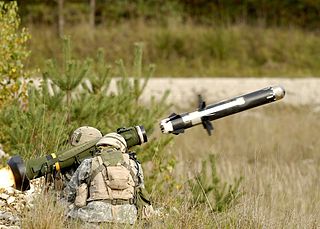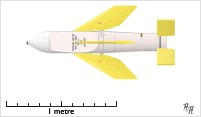
An anti-tank guided missile (ATGM), anti-tank missile, anti-tank guided weapon (ATGW) or anti-armor guided weapon is a guided missile primarily designed to hit and destroy heavily armored military vehicles. ATGMs range in size from shoulder-launched weapons, which can be transported by a single soldier, to larger tripod-mounted weapons, which require a squad or team to transport and fire, to vehicle and aircraft mounted missile systems.

The Haflinger is a small, lightweight, four wheel drive, high mobility cab over vehicle about 3.5 m long and 1.5 m wide, powered by a 643 cc flat twin horizontally opposed, rear mounted, air-cooled engine. Weighing around 600 kg (1322.8 lb), the Haflinger can be lifted by four strong people and yet can carry a load of 500 kg (1102.3 lb). This truck falls into the category of the light utility vehicle. It was produced between 1959 and 1974 by the Austrian manufacturer Steyr-Daimler-Puch.

Rapier is a surface-to-air missile developed for the British Army to replace their towed Bofors 40/L70 anti-aircraft guns. The system is unusual as it uses a manual optical guidance system, sending guidance commands to the missile in flight over a radio link. This results in a high level of accuracy, therefore a large warhead is not required.

Seacat was a British short-range surface-to-air missile system intended to replace the ubiquitous Bofors 40 mm gun aboard warships of all sizes. It was the world's first operational shipboard point-defence missile system, and was designed so that the Bofors guns could be replaced with minimum modification to the recipient vessel and (originally) using existing fire-control systems. A mobile land-based version of the system was known as Tigercat.

The M47 Dragon, known as the FGM-77 during development, is an American shoulder-fired, man-portable anti-tank guided missile system. It was phased out of U.S. military service in 2001, in favor of the newer FGM-148 Javelin system.

The Saab Bofors Dynamics NLAW, also known as the MBT LAW or RB 57, is a fire-and-forget, lightweight shoulder-fired, and disposable (single-use) line of sight (LOS) missile system, designed for infantry use. The missile uses a soft-launch system and is guided by predicted line of sight (PLOS). It can carry out an overfly top attack (OTA) on an armoured vehicle, or a direct attack (DA) on structures and non-armoured vehicles.

The Malkara was one of the earliest guided anti-tank missiles (ATGMs). It was jointly developed by Australia and the United Kingdom between 1951 and 1954, and was in service from 1958 until gradually replaced by the Vickers Vigilant missile in the late 1960s. It was intended to be light enough to deploy with airborne forces, yet powerful enough to knock out any tank then in service. The basic form was later adapted for the short-range surface-to-air role as the Seacat and influenced the development of the Ikara.

The Vickers Vigilant was a British 1960s era MCLOS wire-guided anti-tank missile used by the British Army. It was also licence-built in the United States by Clevite for the US Marine Corps, and sometimes known as Clevite rounds in this case.

The 9M14 Malyutka is a manual command to line of sight (MCLOS) wire-guided anti-tank guided missile (ATGM) system developed in the Soviet Union. It was the first man-portable anti-tank guided missile of the Soviet Union and is probably the most widely produced ATGM of all time—with Soviet production peaking at 25,000 missiles a year during the 1960s and 1970s. In addition, copies of the missile have been manufactured under various names by at least six countries.

The SS.11 is a French manual command to line of sight wire-guided anti-tank missile manufactured by Nord Aviation. It is also available in the air-to-ground version, AS.11, which featured a stabilized sighting system. The AS.11 was also known as the AGM-22 in American service. It is among the earliest guided anti-tank missiles, entering service with the French Army in 1956 and remaining in service into the 1980s. It also formed the basis for the larger and longer-ranged SS.12/AS.12 series.
The SS.12 and AS.12 are two variants of the same missile: SS for surface-to-surface and AS for air-to-surface. It was designed in 1955–1957 by Nord Aviation, later Aérospatiale. It was a derivative of the NORD SS.10 and SS.11 missiles which were surface-to-surface wire-guided missiles for use by infantry, vehicle or a helicopter primarily in the anti-tank role, but also anti-material, anti-personnel and against light field fortifications. The SS.12/AS.12 was basically a scaled-up version of the SS.11/AS.11, with a massive increase in range and warhead weight. The SS.12/AS.12 original mission was primarily to be anti-shipping from naval helicopters and combat aircraft or ground launchers, and secondarily for use against heavy field fortifications. The range and the destructive power of its warhead are roughly equivalent to a 127 mm (5-inch) artillery shell.

The RBS 56B BILL 2 Anti-Tank Guided Weapon is a man-portable or vehicle-mounted guided anti-tank missile using the overfly top attack method to attack the weaker parts of an armoured vehicle. BILL is acronym for Bofors Infantry Light & Lethal.

The HJ-9, HongJian-9, military designation AFT-9, is an advanced, third-generation, man-portable or vehicle-mounted anti-tank guided missile system deployed by the People's Liberation Army Ground Force.

The Cobra was a Swiss/West German anti-tank missile designed by the Oerlikon-Contraves and Bölkow GmbH companies. It entered service with the German Army in the late 1950s. It was followed by the Cobra 2000 and Mamba missile systems, which were upgrades that improved the guidance system and performance of the missile. The missile had limited distribution in the United States by Daystrom Inc., a licensed U.S. distributor, chiefly for evaluation purposes

The Mosquito was an Italian wire-guided anti-tank missile developed by the Swiss firm Contraves AG in close cooperation with the German firm of Bölkow, and produced by its Italian subsidiary Contraves Italiana SpA. It entered service with the Italian Army in 1961 and Indonesian armed forces. It was broadly similar to anti-tank missiles of the era, having a fibreglass body with four large wings, cruciform in cross-section and a relatively short body.

The RBS 56 BILL is a Swedish manportable SACLOS wire-guided anti-tank missile developed by AB Bofors. Development began in 1979 and entered production in 1985. The Swedish Army began receiving the missile in March 1988. BILL stands for. By 1996, 15,000 missiles had been produced and supplied to the Swedish and Austrian armies. Between 1996 and 1997 Brazil received a number of missiles. In the late 1990s production shifted to the RBS 56B BILL 2. The Swedish army received the first deliveries of the BILL 2 in 1999.

The AS-30 was an air-to-ground missile built by Nord Aviation. It was a precision attack weapon designed to be used against high-value targets such as bridges and bunkers. The AS-30 was essentially a larger version of the earlier AS-20 design, and initially used that weapon's guidance system, which required pilots to track the weapon visually and correct its path using a small joystick, while also flying their own aircraft. All such MCLOS systems proved very difficult to use in practice. The updated AS-30L replaced this system with a semi-active laser homing system, which allows the missile to fly to the target without operator intervention. About 60 AS-30Ls were launched during Operation Desert Storm and Operation Deliberate Force with great success.

The Mathogo is an Argentine first-generation wire-guided anti-tank missile.

The FV1620 Humber Hornet was a specialised air-deployable armoured fighting vehicle designed to carry the Malkara, an anti-tank guided missile developed by Australia and the United Kingdom.

ALAS is a Serbian long-range multipurpose wire guided missile system developed by the private company EdePro and the state-owned Yugoimport SDPR. The ALAS missile system was developed primarily for missions against tanks, armored vehicles, fortifications, command posts, low-flying helicopters, coastal ships, industrial facilities and bridges. It can be deployed by any suitable platform including helicopters, armored vehicles, small ships and infantry. The guidance system is based on video/infrared technology, with the missile connected to the launcher by a fiber-optic cable. The ALAS flies at low altitude and has small radar and infrared (heat) signatures due to using a turbofan motor instead of a turbojet. In recent years, the ALAS platform has found a secondary use as a UAV.



















